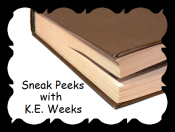 |
| This feature is presented by guest blogger, K.E.Weeks. |

The first thing that struck me about The Hunger Games by Suzanne Collins was its similarity to the short story “The Lottery” by American writer Shirley Jackson (http://www.classicshorts.com/stories/lotry.html). The premise is similar: youngsters are drawn via lottery to be “sacrificed” for the greater good.
The Hunger Games is a science fiction novel, set in the future when North America has become a new country, Panem, where the frivolous Capitol politicians living in what used to be the Rocky Mountains control the citizens living in the other twelve districts. To pay homage to the Capitol and repent for revolting 74 years earlier, the outlying twelve districts annually must send one boy and girl between 12 – 18 years old to the Hunger Games where they must fight to the death with the other tributes. The Hunger Games are shown on TV nightly to the entire nation and are mandatory viewing.
Sixteen-year-old Katniss Everdeen is barely scraping by in District 12—what was once called Appalachia—with her mother and younger sister Primrose, when Prim is chosen to be the district’s female tribute during a ceremony called The Reaping. Katniss volunteers to take her sister’s place, an almost unheard of act.
Katniss is a survivor, who has been hunting in illegal poaching grounds since her father died several years earlier, but she still has little chance of surviving the bloodthirsty “Careers” from other districts who train and desire to be tributes. Her male counterpart is Peeta, the son of the town baker, who is friendly, kind, and charismatic, but whose primary talent is decorating cakes, not killing. They are thrown into the arena with 22 other tributes and the game makers “twists,” such as strange man-made beasts, like muttations. Throughout the game, Katniss feels conflicted over her feelings for Peeta and Gale, her childhood hunting friend back in District 12. Of course, she cannot allow her feelings to overshadow her survival instinct, as, according to the rules of the Hunger Games, at best, only one of them—Peeta or she—will be permitted to survive.
The Hunger Games is a well-constructed science fiction world with well-developed main characters and interesting twists. It presents intriguing political and socio-economic questions with connections to the present. It is a page-turner with action and romance, destined to be well-liked by both boys and girls middle school age and up.
Romantic scenes are restricted to kissing and snuggling together at night for warmth. The book is violent—seeing as one of the main premises’ is killing—but not gory. The violence moves the story along and is smart and interesting, such as death from Tracker Jackets (a type of killer hornet). It is not violent for violence’s sake. At its heart, it is a survival story, and those who like survival TV shows like Man vs. Wild with Bear Grylls would enjoy it.
As is the case with many series, the author ends the book with a key question unanswered, which is somewhat irritating for the reader. Despite my mild disenchantment in the ending, the book is clever and intelligent, and I recommend it heartily with five stars (out of five).

Spoiler alert! Some of the details in this review and the next one will give away parts of the first book.
The second book in the series is called Catching Fire, and here Katniss returns to the arena with Peeta for the Quarter Quell, a special Hunger Games held every 25 years. The 75th Quarter Quell is populated by past Hunger Game winners, sort of a “Survivor Favorites” idea. There is talk of a rebellion against the Capitol, and small signs of it as Katniss and Peeta embark on a Victory Tour, but neither Katniss nor Peeta realize what is in store for them in the arena. The violence in this book is grittier, including a public whipping. This book is interesting, but like many sequels, is not as compelling as the original. The ending is odd and unsatisfactory. I rate it four stars (out of five).

The final book in the trilogy is Mockingjay, named after a new breed of bird, a cross between a Tracker Jay and a Mockingbird. The book is about life in District 13 and the new rebellion, of which Katniss is the symbolic head. Katniss works with the leader of District 13, Coin, but often feels left out of the action and strategy, a pawn for both sides.
This book is greatly disappointing and not worthy of the other two. Despite her pledges of love, Katniss barely pays any attention to her mother and sister. What is most annoying, however, is the fact that Gale, Peeta, Haymitch, and even Katniss act completely out of character. There is a lot of mental illness and drug usage, both illegal and prescription. The story just takes a turn for the strange. Eventually, the characters act out a “real-life” Hunger Games on their way to take the Capitol, which adds some interesting action, but up until that point there are pages upon pages of teenage brooding and moodiness.
Mockingjay is a substandard ending to an otherwise interesting story in a clever fantasy-world. I struggled with how many stars to give this, since fans of the series will probably enjoy it, just because they are able to “live” in Panem for a little longer. However, the book is so unsatisfactory, that some fans may feel cheated (I did). In the end, I settled for three stars (out of five). I’d almost recommend readers stop reading the series after the second book.
Disclaimer: The purpose of this review is to guide parents into selecting appropriate, significant, high-quality literature for their teens and tweens. I have no connection with the author or publisher of this book. I am a home educator of two children, 12 and 14, with a Master of Art degree in American Literature and a keen interest in young adult fiction and nonfiction.















